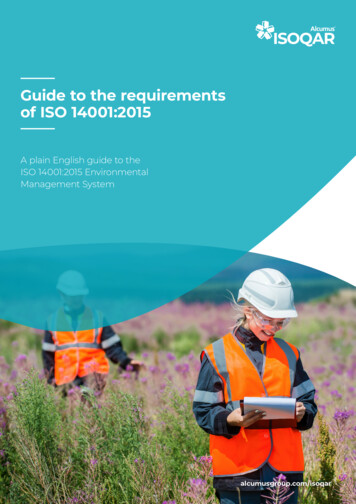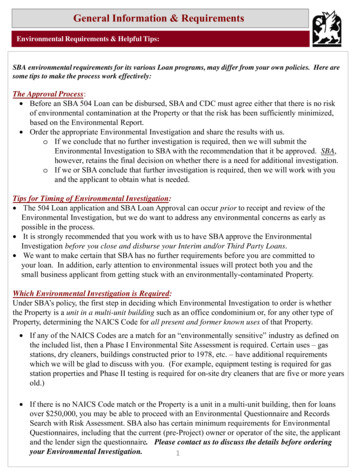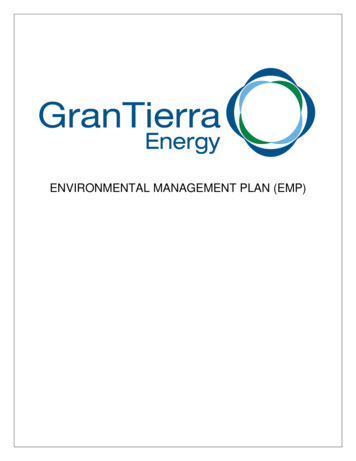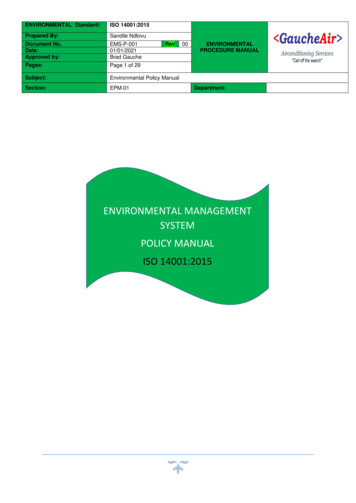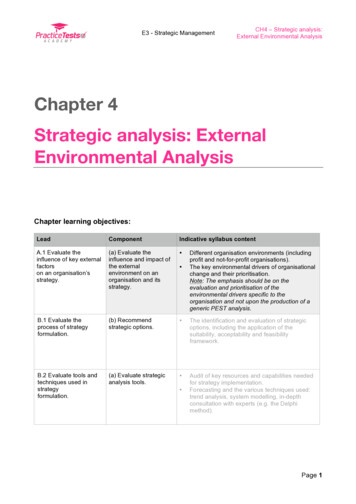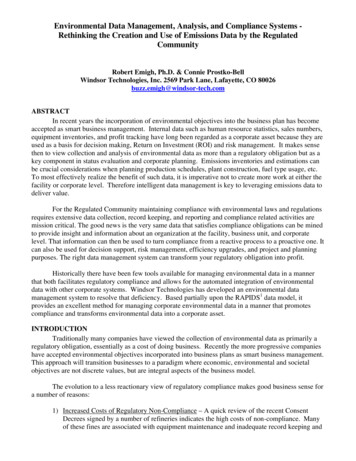
Transcription
Environmental Data Management, Analysis, and Compliance Systems Rethinking the Creation and Use of Emissions Data by the RegulatedCommunityRobert Emigh, Ph.D. & Connie Prostko-BellWindsor Technologies, Inc. 2569 Park Lane, Lafayette, CO 80026buzz.emigh@windsor-tech.comABSTRACTIn recent years the incorporation of environmental objectives into the business plan has becomeaccepted as smart business management. Internal data such as human resource statistics, sales numbers,equipment inventories, and profit tracking have long been regarded as a corporate asset because they areused as a basis for decision making, Return on Investment (ROI) and risk management. It makes sensethen to view collection and analysis of environmental data as more than a regulatory obligation but as akey component in status evaluation and corporate planning. Emissions inventories and estimations canbe crucial considerations when planning production schedules, plant construction, fuel type usage, etc.To most effectively realize the benefit of such data, it is imperative not to create more work at either thefacility or corporate level. Therefore intelligent data management is key to leveraging emissions data todeliver value.For the Regulated Community maintaining compliance with environmental laws and regulationsrequires extensive data collection, record keeping, and reporting and compliance related activities aremission critical. The good news is the very same data that satisfies compliance obligations can be minedto provide insight and information about an organization at the facility, business unit, and corporatelevel. That information can then be used to turn compliance from a reactive process to a proactive one. Itcan also be used for decision support, risk management, efficiency upgrades, and project and planningpurposes. The right data management system can transform your regulatory obligation into profit.Historically there have been few tools available for managing environmental data in a mannerthat both facilitates regulatory compliance and allows for the automated integration of environmentaldata with other corporate systems. Windsor Technologies has developed an environmental datamanagement system to resolve that deficiency. Based partially upon the RAPIDS1 data model, itprovides an excellent method for managing corporate environmental data in a manner that promotescompliance and transforms environmental data into a corporate asset.INTRODUCTIONTraditionally many companies have viewed the collection of environmental data as primarily aregulatory obligation, essentially as a cost of doing business. Recently the more progressive companieshave accepted environmental objectives incorporated into business plans as smart business management.This approach will transition businesses to a paradigm where economic, environmental and societalobjectives are not discrete values, but are integral aspects of the business model.The evolution to a less reactionary view of regulatory compliance makes good business sense fora number of reasons:1) Increased Costs of Regulatory Non-Compliance – A quick review of the recent ConsentDecrees signed by a number of refineries indicates the high costs of non-compliance. Manyof these fines are associated with equipment maintenance and inadequate record keeping and
2)3)4)5)6)7)reporting. Corporations have increased incentive to stay ahead of the game with respect tocompliance in order to avoid costly litigation and fines.Better Real-time Data Acquisition & Analysis Tools– Acquisition and analysis of real timeenvironmental and process data has matured in recent years. What was previouslyimpossible or unfeasible is now simpler thanks to improvement in monitoring technology.Equipment, stacks, and outfalls can be scrutinized directly and the data analyzed immediatelyminimizing accidental releases, quickly identifying equipment operating out of tolerances,and ensuring that equipment is operating optimally.Leveraging Enterprise and ERP Systems – Many large organizations have invested inEnterprise Resource Planning (ERP) systems, e.g., SAP, PeopleSoft, and Oracle E-BusinessSuite11i. These systems can interface with environmental data systems and providecorporate views of local environmental databases providing information about emissions,equipment, maintenance, operator certification, and training.Introduction of Market Trading Systems2 – Due to the implementation of air pollutant basedmarketing / selling / buying systems, many companies now have an asset that must bemanaged. Usually if the total pollution for a period of time is less than a capped value, thenthe unused pollution units can be sold or banked for later use. Therefore it has become moreimportant to have and use reliable emission data.Responsible Corporate Citizenship – Many companies have determined that there is a valueto the company if it is considered to be a “green” company. Consumers have access to anoverwhelming amount of information about companies and their actions via television, radio,and the Internet. The increased availability of news and information has raised publicexpectations of corporate social performance. There is a value associated with anenvironmental approach to environmental regulations.Availability of Enterprise Ready Environmental Data Management Systems- The marketplace now offers environmental data management systems which support a proactiveapproach to emission, process and compliance management.Corporate Merger and Acquisition Hyperactivity – The sustained trend common to manyindustries is seemingly constant merger and acquisition activity. As a corporation grows is itcrucial to assess the process efficiency and environmental performance of new facilities inthe organization in order to minimize risk, maximize profitability, and effectively planproduction. Therefore having a strong, centralized environmental data management systemthat seamlessly accepts new entities is a critical factor in sound management.Each of these variables has a measurable value in the corporate setting. Savvy, strategic use ofInformation Technology has been an enormous contributing factor in the positive trajectory the USeconomy has plotted over the past 15-20 years. Mining compulsory data to produce information andthen transforming that information into knowledge creates a benefit where there was only a cost. Thequestion, of course, is exactly what benefit? The accepted method of defining this value is to perform anROI calculation. The challenge lies in determining a general method of calculating ROI forenvironmental data systems that accurately quantifies the value of such a system to a corporation. Thehighest hurdle is establishing metrics, both tangible and intangible.1) Establishing what it costs to do the work now, and what it would cost after implementing anenvironmental data management system.2) Estimating what further costs are avoided or minimized by accomplishing the same functionsunder a different paradigm.3) Estimating and quantifying the entirely new benefits to be realized by using compulsory datagathered at a local level to generate information for decision making at a global level.
WHAT IS ENVIRONMENTAL ROI?The key question is how does one measure the ROI of environmental data management, analysis,and compliance technology? It’s one of many approaches to calculating the value of a capitalinvestment. ROI traditionally equates with “cost savings.” This is calculated as the total value or returnminus the total cost (the savings) divided by the total cost. Breaking down each factor into quantifiablepieces is simply a matter of understanding and developing a method for calculating them. Bycalculating the savings, returns, and costs of each variable, one can calculate the total ROI.It’s all about the bottom line The practical difficulty of calculating ROI is quantifying each variable. While the ROI equationis standard, environmental data management has introduced a new set of variables not standard tonormal data management technologies. One can measure software investments in dollars and estimatemanpower by calculating the hourly cost of each individual. But the real question is how one wouldfactor in such variables as technological innovation; the competitive edge gained through minimizingpollution and maximizing efficient processes; and goodwill generated by being a good environmentalcorporate citizen.The USEPA and others are developing an increasing number of methodologies to help measurethe intangibles of environmental data management and present them in a financial light. These variousmethodologies create quantifiable models for business concepts such as the market value of pollutionunits; the financial impact of the regulatory environment, more and better real time environment data;corporate database integration; and public perception of the company.One of the critical purposes of calculating ROI is the determining how to increase ROI. Theeconomic goal of virtually every market is optimal efficiency, and technology is the principal agent forefficiency gains. This is specifically true of environmental data systems. By using technology tominimize pollution, one can optimize the efficiency of the desired processes and maximize profitThe ROI over time The ROI can be extended over time by using other indices. For example, there is "net presentvalue" (NPV), which calculates future savings in terms of current dollars and maps that to investmentcosts. To the extent that future savings exceed the total investment, the benefits exceed the cost.Another approach is the "internal rate of return" (IRR), which focuses exclusively on future cash flowsderived from an asset or investment. If the cost of capital is less than the IRR, there will be financialbenefits from the initial investment.
Extending the Environmental ROI The ROI described above provides a core foundation for calculating the benefit of environmentaldata management, analysis and compliance software. The formula described above can be modifiedslightly for the environmental arena: Add "savings" and "derived income," and divide the sum by"investment." In this formula, "savings" refers to savings in operational costs and processes as well assavings derived through improved performance and greater efficiency of engineering processes. Byminimizing pollution, the engineering processes are optimized for what they were intended. Derivedincome can be calculated from these more efficient engineering processes. By tracking all reportingrequirements, many of the costs associated with penalties can be minimized or eliminated.This business focus for environmental data is underscored by new approaches such as "return onopportunity," which focuses on revenue, and "return on asset," which focuses on profitability.Quantifying these advantages can be difficult for environmental data. The key to an accurate ROIassessment is to know the particular operational / regulatory environment.There are some key factors to consider:1) Cost – Calculating the cost of the environmental data management, analysis and compliancesoftware is the first place to start. One must look at the costs of all the components,including installation costs in terms of services and internal labor and in-house personneltraining (price and labor).2) Deployment Timing – This is an additional part of the cost and it has both negative andpositive implications for a good environmental data management solution. For an enterprisebusiness, time to deployment will directly impact internal business efficiencies, either bydisrupting them, or by delaying the availability of a new service.3) Environmental Data History – It is important to be able to measure improvement against apast condition. For example, one could look for compliance violation reduction or loweraverage pollution values. One should also look for less obvious metrics: Does theenvironmental data management software enable one not only to deploy professionals moremeaningfully, but also to begin restructuring to achieve new organizational dynamics? Canproduction be increased while maintaining compliance with the required emission limits?In the perfect ROI study, a full record of past conditions would be documented and then the samemetrics would be applied to the new conditions with new software.The first question to ask about ROI is, exactly what is being assessed and why measure it?Calculators for specific products are good examples of this. They are all designed with a clear productfocus in mind: to assess the likely predicted ROI potential in a wide range of environments. In otherwords, they are designed to show why - and to some degree, how - a specific environmental softwareproduct is a good investment. One is probably better off by conducting one’s own ROI analysis.Good environmental ROI data very often can be gained directly through environmental datamanagement, analysis and compliance software. With this type of software, one can gain substantialdetails about how the environmental management practices are performing. The bad news is that ifthese are the products, or components of the products one is seeking to evaluate, then there is no priorcase. There will be no history against which it can be compared.
So what should one do? The solution maybe to perform a manual analysis or do an analysis on asubset of the data if a desktop system was used previously. If there are no previous data, then the bestone can do is to benchmark the new software to measure progress as the software becomes integratedinto the organization.MAXIMIZE ENVIRONMENTAL DATA MANAGEMENT ROIIn the previous section we discussed the key issues and approaches in calculating anenvironmental ROI. There are really two purposes for which an environmental ROI can be used. Thefirst is to evaluate environmental data management, analysis and compliance systems to identify the costbenefits of implementing such a system. In larger organizations, a one to two year return on investmentis possible. Many organizations go through this type of ROI to determine if a new environmentalsystem should be developed / purchased.The second, and more important, use of an environmental ROI is to manage the environmentaldata as a corporate asset to contribute to the success of the company. Maximizing the environmentalROI would contribute, sometimes significantly, the bottom line of the company.Based upon maximizing an environmental ROI, there are a number of criteria that anenvironmental data management, analysis and compliance system should have:1) Event tracking module – The environmental data management system should have a flexible,industrial strength scheduling and tracking module. The module should have flexibility totrack any compliance deadline or deliverable, document, event, or any item that has a timeconstraint. It should be able to use alarms (e.g., e-mails, log files, messages) to alert onewhen specific limits are being approached or have been exceeded.2) Enterprise system that interfaces with corporate systems – The environmental datamanagement system should be an enterprise system that interfaces with corporatemanagement systems. For example, using an environmental data system for one facilitywould not produce benefits company-wide as the data would not well integrated (if at all)with other corporate data and local data would be unavailable to off-site stakeholders withinthe organization. Similar or identical data would be stored in multiple systemscompromising data integrity and creating data redundancy representing duplicate efforts.3) Real time data acquisition module – There is a need to obtain some of the environmental dataon a real time basis. Measurements can be compared with permitted conditions to determinedata discrepancies or incidents that should be analyzed.4) Maintenance and leak detection module – If any equipment has leaks or is not maintainedregularly, then the equipment is not operating optimally. In addition, leaks and repairs can beregulated and tracked. Problem equipment types can be identified. By minimizing equipmentproblems and failures, repair costs and downtime can be minimized.5) Capacity to maintain extensive history for record keeping & analysis – To calculate anongoing environmental ROI, there needs to be a history of emissions, throughputs,equipment, maintenance, permit conditions, regulatory conditions, and the like. These datawould be analyzed to determine business strategies to increase the ROI.COMMERCIAL ENVIRONMENTAL DATA MANAGEMENT SYSTEMSHistorically, there have been few automated tools available for managing multi-media corporateenvironmental data in a manner that both facilitates the satisfaction of regulatory obligations and allowsfor the automated integration of environmental data with other corporate systems. Most environmentalsystems have focused on helping the facility meet the regulatory requirements. Such a system can bedefined as a “compliance-centric” system.In recent years environmental objectives incorporated into the business plan have becomeaccepted as smart business management. Internal data such as human resource statistics, sales numbers,equipment inventories, and profit tracking have long been regarded as a corporate asset because they areused as a basis for decision making and risk management. It makes sense then to view collection and
analysis of environmental data as more than a regulatory obligation but as a key component in statusevaluation and corporate planning. For example, emissions inventories and estimations can be crucialconsiderations when planning production schedules, plant capacity, fuel type usage, etc. Intelligent datamanagement is key to making emissions data a corporate asset. Such a system can be defined as a“environmental ROI-centric” system.Currently, there are several commercial compliance-centric systems available. However, thenew generation of environmental data management, analysis and compliance systems is designed toassist with maximizing the Environmental ROI in addition to meeting the regulatory and compliancerequirements. In this paper we briefly describe the Ennovation suite of products, an environmental ROIcentric system.The Ennovation SuiteThe Ennovation environmental data management, analysis, and compliance system is designedto be environmental ROI-centric. It offers a toolset for managing corporate environmental data in amanner that reduces the administrative burden associated with regulatory obligations, promotescompliance with permit conditions and environmental laws and regulations, and transformsenvironmental data into a corporate asset.Technical ApproachThe Ennovation suite is a modular application, which can be installed as a complete package orincrementally. At the core of this system is the proven RAPIDS data repository, with over 5 millioninvested in development costs. The RAPIDS environmental data repository make extensive use offlexible attributes. This allows the user to add new parameters to the data repository without having tochange the data model. Figure 1 shows the conceptual technical diagram of the RAPIDS model.Key ModulesThere are number of modules that support the Ennovation suite. The key components of thesystem are:1) Environmental Data Repository (EDR) – As stated above, the EDR is based upon theRAPIDS data model and is the basis of the system.2) Emission Inventory System (EMS) – The EMS manages air emission inventories, includingcriteria and toxics; solid waste streams; and wastewater / storm water streams. Theinformation would be used for reporting, permitting and compliance activities.3) Facility Management – The Facility module can store and manage facility and process datafor every site in the organization. Here one could customize roll-up levels to evaluate databy region, business unit, state, or other definable parameter.4) Scheduling & Events Tracking System (SETS) – The SETS module would allow the user toautomate event scheduling and tracking and to generate reminders and other actions. Onecould can schedule e-mails to remind the responsible party when a certain report, such as aDMR is due to the state.5) Analysis & Reporting (enSight) – The analysis portion of the system facilitates thecomparison and analysis of environmental data to improve the performance of devicescreating pollution. In general, minimizing the creation of pollution would maximize theresources used for the business. The module allows for “what if” scenarios to be analyzed.The reports part of the module would generate canned, custom, and ad-hoc reports.6) Compliance & Permitting – The Compliance & Permitting module would allow the user tocompare actual measurements to permitted values and run “what if” scenarios. This modulecould be used to store and manage permit applications and permits. From the compliancemodule the user could access a past permit application and easily create a similar application
for submittal by editing the appropriate fields. Combined with SETS it would be a powerfultool for monitoring compliance status company-wide.7) Exchange Interface – This module would allow for data import and export to and from otherdatabases, including regulatory databases.8) ERP Interface – The ERP Interface would allow for automated data exchange with EnterpriseResource Planning software such as the SAP BIW (Business Information Warehouse) andPeopleSoft. This allows for the integration of ERP inventory, training, maintenance andother business related modules.9) Laboratory Information Management System (LIMS) Interface – The LIMS module wouldallow for automated data exchange with a Laboratory Information Management System.10) Environmental Data Acquisition – The data acquisition module provides an interface tovarious monitoring equipment via the data logger. The measurements can be compared withconditions to determine data discrepancies or incidents that should be analyzed. This moduleworks in conjunction with SETS to provide automated comparisons, including earlywarnings if equipment is going out of limits.These modules address the ROI criteria that we identified earlier to maximize environmentaldata management ROI.CONCLUSIONModern business practices incorporate environmental objectives into the business plan. It makessense then to view collection and analysis of environmental data as more than a regulatory obligation butas a key component in status evaluation and corporate planning. Developing an environmental ROI is agood start in determining how the evaluate and manage environmental data. There are ROI-centricsystems that are beginning to be available commercially to automate the management of environmentaldata.REFERENCES1) “Overview of the RAPIDS System,” ml2) R. A. Emigh, et. al. “The Illinois Emissions Reduction Market Computer System”, Presented at the1998 AWMA Emission Conference, New Orleans, Louisiana, December 1998; page 911.KEYWORDSEmission Inventory SystemROIEnterprise Resource Planning SystemsComplianceEnvironmental Data Management, Analysis and Compliance SystemRAPIDSEnterprise System
Figure 1. Conceptual Technical Diagram of the RAPIDS ESSSTREAMACTIVITYNEW SPECIATIONDATASCCFIRESPECIATE
to provide insight and information about an organization at the facility, business unit, and corporate level. That information can then be used to turn compliance from a reactive process to a proactive one. It can also be used for decision support, risk management


